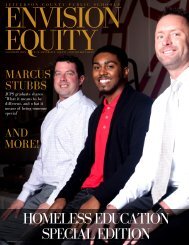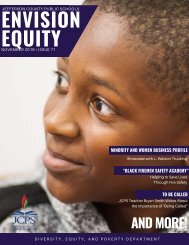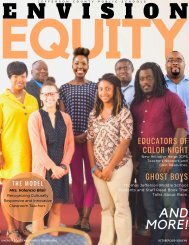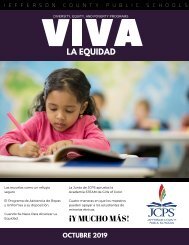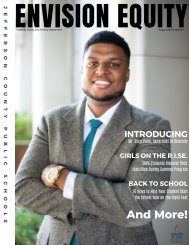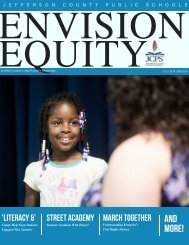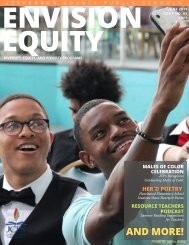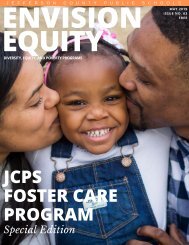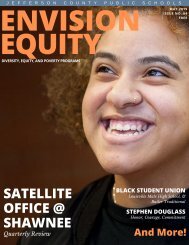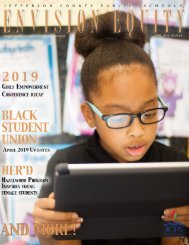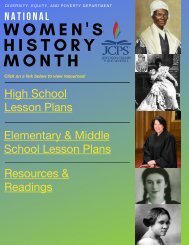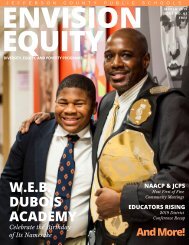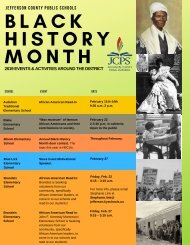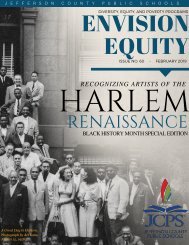September 2019 Envision Equity
Create successful ePaper yourself
Turn your PDF publications into a flip-book with our unique Google optimized e-Paper software.
ENVISION<br />
EQUITY<br />
G I R L S O F C O L O R S T E A M A C A D E M Y<br />
A F R I C A N A M E R I C A N S T U D I E S<br />
T H E M O D E L<br />
AND MORE!<br />
!1
JCPS BOARD<br />
APPROVES GIRLS<br />
OF COLOR STEAM<br />
ACADEMY<br />
By Abdul Sharif, Generalist—Diversity, <strong>Equity</strong>,<br />
and Poverty Department<br />
On August 28, <strong>2019</strong>, the Jefferson<br />
County Board of Education (JCBE)<br />
unanimously approved an academy tailored<br />
to middle school girls of color, which will<br />
open during the 2020-21 school year.<br />
Much like the W.E.B. DuBois Academy for<br />
boys, the girl’s academy will be aimed at<br />
promoting student equity and will have an<br />
Afro-centric curriculum and classes that<br />
focus on science, technology, engineering,<br />
art, and mathematics (STEAM).<br />
During the August 28 JCBE meeting, several<br />
community members voiced their support<br />
for the girls of color academy. Louisville<br />
Continue on next page<br />
2<br />
Photos: Continue Abdul on next Sharif page
Urban League president Sadiqa Reynolds, Bates Memorial Baptist Church<br />
Pastor Bruce Williams, AMPED CEO Dave Christopher, Metro Councilwoman<br />
Jessica Green, and several others attended the meeting to let JCBE members<br />
know why they support the girls of color academy.<br />
“It is time for us to have an opportunity to do for ourselves what it seems that<br />
the system has not been able to successfully do," Sadiqa Reynolds told board<br />
members. "Somehow, it seems that people in our community and our<br />
country have been convinced that little black girls and girls of color, brown<br />
girls, cannot learn in the same way that others can," Reynolds said. "And what<br />
we would like the opportunity to do is to show you just like with these boys,<br />
that there is something wrong with the system. There's nothing wrong with<br />
them." Reynolds continued.<br />
Additionally, Metro Council<br />
Woman Jessica Green<br />
compared the girls of color<br />
academy to her alma mater,<br />
Spelman College in Atlanta. "A<br />
single-sex institution<br />
dedicated to women of color<br />
decreases the amount of time<br />
a woman or girl has to spend<br />
Council Woman Jessica Green.<br />
fighting gender stereotypes in<br />
the classroom," Green said. "You can focus on learning. You can focus on<br />
soaring."<br />
To help the community understand why our district needs a girls of color<br />
academy, our office will be holding a series of girls of color community<br />
conversations.<br />
Continue on next page<br />
!3
Staring on October 17 at the<br />
W.E.B. DuBois Academy, Dr.<br />
Crystal deGregory will present on<br />
the importance of the HBCUs and<br />
a sense of belonging for girls of<br />
color. On January 22 at the<br />
W.E.B. DuBois Academy, Dr.<br />
Cherie Dawson-Edwards will<br />
present on the history and<br />
examples of injustice inside the<br />
school system. On March 25 at<br />
the W.E.B. DuBois Academy, Sam<br />
O’Bryant from SchoolSeed in<br />
Memphis, TN, will share his<br />
research on what an urban city<br />
needs to do in order to loosen the<br />
Diversity, <strong>Equity</strong>, and<br />
Poverty Department<br />
GIRLS OF<br />
COLOR<br />
COMMUNITY CONVERSATIONS<br />
Please join us for our <strong>2019</strong>-20 Girls of Color Community<br />
Conversations, featuring local and national experts who<br />
will share their research, best practices, and strategies to<br />
teach and reach girls of color in our public schools.<br />
Dates & Speakers<br />
Dr. Crystal deGregory, Independent Scholar<br />
Dr. Cherie Dawson-Edwards, University of Louisville<br />
October 17 | 6–8 p.m. | W.E.B. DuBois Academy<br />
Dr. Crystal deGregory will present on the<br />
importance of the HBCUs and a sense of belonging for<br />
girls of color.<br />
January 22 | 6pm–8pm | W.E.B. DuBois Academy<br />
Dr. Cherie Dawson-Edwards will present on the history<br />
and examples of injustice inside the school system.<br />
Sam O’Bryant, SchoolSeed, Memphis<br />
March 25 | 6pm–8pm | W.E.B. DuBois Academy<br />
Sam O’Bryant from SchoolSeed in Memphis, TN, will<br />
share his research on what an urban city needs to do in<br />
order to loosen the grip of whiteness and proliferate<br />
equity.<br />
April 23, 2020 | 6pm–8pm | Louisville Urban League<br />
Dr. Shantel Crosby will discuss the book Sister Citizen iz<br />
and<br />
the disparate impact befallen Black girls.<br />
For more information, or to R.S.V.P., please contact Vanessa McPhail at<br />
485-3631 or email vanessa.mcphail@jefferson.kyschools.us.<br />
Dr. Shantel Crosby, University of Louisville<br />
grip of whiteness and to proliferate equity. And lastly, on April 23 at the<br />
Louisville Urban League, Dr. Shantel Crosby will discuss the book Sister<br />
Citizen and the disparate impact befallen Black girls.<br />
Each Community Conversation will take place from 6 p.m. to 8 p.m. All<br />
community members are encouraged to attend!<br />
For more information, please contact Vanessa McPhail at 485-3631 or<br />
vanessa.mcphail@jefferson.kyschools.us.<br />
!4
The Model<br />
Recognizing Culturally Responsive and Innovative Classroom Teachers<br />
Name: Bryan Smith<br />
School: Frederick Law<br />
Olmsted Academy North<br />
Growing up in a small town in<br />
western Kentucky, Bryan Smith and<br />
his siblings grew up in a close Christian<br />
community. Living in a single parent<br />
household, Bryan experienced economic,<br />
social, and cultural hardships. “I never<br />
really paid attention to the fact that my<br />
father was missing. We never had time to<br />
feel the void,” stated Bryan Smith. New<br />
challenges occurred once his family<br />
relocated to a city in Georgia. “When we<br />
moved, poverty became the backdrop of<br />
our lives. Alcoholism, drugs, gangs, and the<br />
threat of “lack” competed daily with our<br />
family values, faith, and<br />
resiliency,” Bryan recalled. Eventually<br />
returning to Kentucky, Bryan pursued his<br />
degree in Education. He now uses his past<br />
experiences to inspire others.<br />
Click here for video story.<br />
5<br />
Continue on next page<br />
Photo: Abdul Sharif
AFRICAN<br />
AMERICAN<br />
STUDIES<br />
ELECTIVE<br />
How Does it Prepare<br />
Students to be Critical<br />
Citizens?<br />
By Ryan New—<br />
JCPS Instructional<br />
Lead Social Studies<br />
The new Kentucky Academic<br />
Standards for Social Studies have<br />
opened up the possibility of really<br />
exploring the historic and contemporary<br />
world through the process of inquiry<br />
based instruction. Gone are the days of<br />
memorizing facts and dates—gone are<br />
also the days of standards that only<br />
reflect European history, people, and<br />
ideas. Inquiry based learning is about<br />
asking compelling and supporting<br />
questions, investigating these questions<br />
through the multidisciplinary lenses of<br />
civics, economics, geography, and<br />
history, exploring and using sources to<br />
build evidence, creating arguments that<br />
answer compelling questions, and taking action in classrooms, schools,<br />
and the community. This course aligns with the backpack of success skills,<br />
help building innovators, communicators, collaborators who will become<br />
more resilient and globally and culturally competent citizens.<br />
While there are great opportunities to explore the historical and<br />
contemporary lives of our global neighbors, electives help us narrow our<br />
investigations to specific groups or events so they can be better understood<br />
in a broader world context. African American Studies is an elective course<br />
that narrows this focus to trace the historical, political, societal, economic<br />
and cultural issues from ancient Africa through to contemporary issues<br />
facing African Americans—especially in a year marking 400 years<br />
(1619-<strong>2019</strong>) since people of Africa were enslaved in the English colonies.<br />
Continue on next page<br />
!6
Students in this elective will<br />
use the inquiry process to<br />
raise questions, explore<br />
sources that provide<br />
necessary perspective,<br />
build arguments, and take<br />
action. The spirit of the<br />
course meets race where it<br />
meets students, using their<br />
lived experiences to<br />
investigate the past while<br />
questioning the present and taking action so that they can experience and<br />
influence their communities in a way that will be worthy of future history.<br />
The course ends in a capstone, wherein students will present on the<br />
knowledge, skills, dispositions, and actions based upon their year long<br />
experiences.<br />
Mansa Musa, the 14th century African king of the Mali Empire.<br />
While we have built a course that we think is a good starting point, our goal<br />
is to make a course like this foundation to all student experiences—part of<br />
the core and not only an elective. This should not diminish this course,<br />
which was inspired by and in some cases, co-created by students of Black<br />
Student Unions across JCPS. Thank you to the students of Atherton,<br />
Seneca, Moore, and TJ Middle, Brown, and duPont Manual who reviewed,<br />
asked questions, and challenged our thinking. Thank you also to Dr.<br />
LaGarrett King, Dr. Ryan Crowely, as well as the resource teachers from DEP<br />
who reviewed the elective and will help make on-going modifications. Our<br />
goal is always to build transformative courses worthy of study and<br />
experience.<br />
!7
Resource Teacher Spotlight<br />
Name: Kennita Ballard<br />
Position: Resource Teacher, Accelerated Improvement Schools<br />
Kennita Ballard is an alternative certification teacher originally from<br />
the Washington D.C. area. Kennita came to the state of Kentucky by<br />
way of the program Teach<br />
Kentucky. She received her Masters<br />
of Arts in Teaching from the<br />
University of Louisville, and is<br />
currently in pursuit of a doctorate<br />
degree of English Pedagogy.<br />
Formerly, Ms. Ballard was a middle<br />
school 6th grade teacher at<br />
Olmsted Academy North where she<br />
engaged, inspired and empowered<br />
students each and every single<br />
day.<br />
Kennita has been recognized for<br />
Photo provided by Kennita Ballard.<br />
her work by being awarded the<br />
<strong>2019</strong> Kentucky Council of Teachers of English (KCTE) Middle School<br />
Language Arts Teacher of the Year. She currently serves on the steering<br />
committee for the Kentucky Center for School Safety (KCSS) and KCTE as the<br />
diversity chair. Ms. Ballard has grown in her capacity as a teacher-leader and<br />
will be functioning as a district DEP resource teacher for the <strong>2019</strong>-20 school<br />
year.<br />
!8
WE DON’T<br />
NEED<br />
ANOTHER<br />
ALLY<br />
By Kennita Ballard—Resource Teacher,<br />
Diversity, <strong>Equity</strong>, and Poverty Department<br />
Photos, Google Images.<br />
Ioften think about these lyrics by the<br />
great Tina Turner, “all the children say,<br />
we don't need another hero, we don't<br />
need to know the way home,” as it applies<br />
to the world of education specifically to<br />
how teachers engage with advocacy and<br />
ally-ship as a performative act. We see this<br />
all too often on social media, where social<br />
media has served as the platform for<br />
performative acts of allyship with<br />
adjectives taking precedent over verbs.<br />
That is not to imply that teachers who<br />
identify as advocates and allies are<br />
disingenuous, but the field of education is<br />
oversaturated with the celebration of and<br />
attention to rhetoric. Understandably so,<br />
Continue on next page<br />
!9
considering that the identity of being an advocate and ally does begin with<br />
rhetoric—the recognition and awareness of power, oppression is the critical and<br />
necessary foundation of any advocacy-based identity. That foundation, in turn,<br />
has to be maintained through consistent awareness of the privilege and power<br />
we have access to, however, there has to be more because there needs to be<br />
more. Our schools' current climate and culture demand that we begin to shift our<br />
mindsets, attitudes and more importantly our actions to standing with others.<br />
More than allies and advocates—our learners, especially those from diverse<br />
populations, deserve and need solidarity workers.<br />
Jon Greenburg, public school educator and creator of the Citizenship and Social<br />
Justice curriculum describes the need best in his blog post Curriculum for White<br />
Americans to Educate Themselves on Race and Racism–from Ferguson to<br />
Charleston.<br />
When teaching about race and racism, I invite participants to consider the<br />
following analogy: Think of racism as a gigantic societal-sized boot.<br />
“Which groups do you think are fighting the hardest against this boot of racism?”<br />
I ask them. Invariably, participants of diverse races answer that those fighting<br />
hardest to avoid getting squashed by the boot are people of color. (Keep in mind<br />
that I don’t ask this question on day one of our study of race. Rather, participants<br />
come to this conclusion after exploring the concept of White privilege and<br />
studying the history of race and racism in the United States through multiple<br />
sources and perspectives.)<br />
“If that’s true,” I continue, “then who do you think is wearing the boot?” The<br />
participants’ answer (though it often only reluctantly hits the air): White people.<br />
Continue on next page<br />
10
ENVISION EQUITY SEPTEMBER <strong>2019</strong><br />
“If that’s true, then whose responsibility is it to stop the boot from squashing<br />
them? The people of color already pushing upward and resisting the boot? Or<br />
the people wearing the boot–consciously or not–who contribute to a system<br />
that pushes downward?”<br />
Everyone has a role in ending racism, but the analogy shows how little sense it<br />
makes for only those facing the heel-end of oppression to do all the work. It’s<br />
time for White America to take on a far bigger role in taking off the boot.<br />
Photo Google Images.<br />
There are no<br />
doubt<br />
complexities that<br />
come with White<br />
Americans<br />
working for<br />
racial justice.<br />
White privilege<br />
can lead to a<br />
chronic case of<br />
undiagnosed<br />
entitlement,<br />
creating poor<br />
listeners, impatient speakers who talk over others, and people unaccustomed to<br />
taking orders. Nevertheless, the movement for racial justice needs more White<br />
Americans to get involved. And it is our responsibility to help each other get<br />
involved—and get involved productively.<br />
Continue on next page<br />
!11
ENVISION EQUITY SEPTEMBER <strong>2019</strong><br />
This productively comes as a result of awareness and action combined, which is<br />
why we as educators<br />
can no longer allow<br />
ourselves to just be<br />
satisfied with being<br />
allies to our diverse<br />
learners. When we<br />
can make the shift<br />
from ally to solidarity<br />
workers, we are<br />
effectively<br />
decentering our roles<br />
in this type of social<br />
justice work and<br />
putting our diverse learners at the center of their empowerment. Solidarity is<br />
not going to come without growing pains, but it is a necessary and needed step<br />
to support the empowerment of disenfranchised populations and the<br />
destabilization of oppressive structures.<br />
Photo Google Images.<br />
!12
<strong>September</strong> <strong>2019</strong><br />
Check out our monthly update video featuring JCPS Chief of<br />
Communications Renee Murphy, and Community Affairs Specialist<br />
Vanessa McPhail, to find out what DEP has coming up this month!<br />
Click Here to Play<br />
!13
J C P S D E P<br />
#AREyoujcps?<br />
Podcast<br />
<strong>September</strong> <strong>2019</strong><br />
The ARE tool stands for "Affirming Racial <strong>Equity</strong>.” It is a tool that teachers can<br />
use in their planning as they strive for racial equity in their classrooms<br />
according to the district's racial equity policy. Professional Learning Communities<br />
(PLCs), and teachers should become comfortable planning with the ARE tool lesson<br />
descriptors in mind as a part of connecting the standards to the learner.<br />
The lesson descriptors of the ARE tool are:<br />
• Content integration<br />
• Knowledge construction<br />
• Prejudice elimination<br />
• Equitable pedagogy<br />
• Empowering classroom culture<br />
• Assessment<br />
The JCPS DEP Resource Teacher team developed this tool using the Center for<br />
Collaborative Education's Building <strong>Equity</strong> in Your Teaching Practice Framework. The<br />
ARE tool is located in the JCPS teacher backpack. Follow us on our journey toward<br />
racial equity #AREyoujcps?<br />
Click here to listen to the <strong>September</strong> <strong>2019</strong> JCPS DEP Resource<br />
Teachers Podcast.<br />
14
DATA MANAGEMENT<br />
RESEARCH TECHNICIAN<br />
Each month we will highlight one of the Diversity, <strong>Equity</strong>, and Poverty Department’s Data<br />
Management Research Technicians. This month we would like to introduce you to Telva Hogan!<br />
Hello my name is Telva Hogan. I proudly support the<br />
work of the Office of Diversity, <strong>Equity</strong>, and Poverty in<br />
my role as a Data Management Research Technician<br />
(DMRT). Originally from a small college town in Northeast<br />
Ohio, I came to Louisville in 1997. I have two children, Tyler<br />
and Kyra, both of whom attended Jefferson County Public<br />
Schools (JCPS).<br />
After working in early childhood education for more than 14<br />
years, and with my own children becoming young adults, I<br />
chose to take a leap of faith, leaving my comfortable job to<br />
come to JCPS as a clerk. I “landed” in DEP after only 5<br />
months with the District. It has been amazing! In the last<br />
three years I have seen the creation of the W.E.B. DuBois<br />
Academy, the passing of the Racial <strong>Equity</strong> Policy, and most<br />
recently the Jefferson County Board of Education approval<br />
of a Girls of Color STEAM Academy.<br />
Through my behind the scenes work in DEP, I am able to be<br />
a part of an incredible effort to positively impact the lives of<br />
our children. Daily, I am challenged to work outside of my<br />
comfort zone and pushed to be my very best. This has<br />
become even more important and personal to me as I<br />
embrace my newest role as a grandmother.<br />
To contact me, please call 485-3506 or email<br />
telva.hogan@jefferson.kyschools.us.<br />
15
ENVISION EQUITY SEPTEMBER <strong>2019</strong><br />
FOUR WAYS<br />
TEACHERS CAN<br />
SUPPORT<br />
STUDENTS OF<br />
COLOR<br />
By Jennifer Gonzalez<br />
The difference between<br />
teachers and their<br />
students has never been<br />
so stark. A recent report from the<br />
National Center for Education<br />
Statistics shows that since 2014,<br />
white students no longer make<br />
up the majority in American<br />
schools. Future projections show<br />
the white population shrinking<br />
to a smaller and smaller<br />
proportion of the whole, and the<br />
combined populations of of<br />
students from other ethnic groups increasing so that together, they make up<br />
a steadily growing majority.<br />
By contrast, teachers in the U.S. are overwhelmingly white.<br />
What this tells me is that the life experiences of most of the people in charge<br />
of our classrooms have been pretty different from the experiences of most of<br />
their students—and that matters.<br />
It matters because our work is not strictly academic. Not by a long shot. In<br />
order for our students to perform well academically, they need to feel safe,<br />
both physically and psychologically. They need to feel a sense of belonging.<br />
They need to feel seen and valued for who they are. For our students of color,<br />
finding this safe, accepting place is rare, especially if most of their teachers<br />
have a dramatically different background from their own. This problem can<br />
be even more pronounced for students of color who attend schools where<br />
their peers are also mostly white.<br />
Continue on next page<br />
!16
ENVISION EQUITY SEPTEMBER <strong>2019</strong><br />
This does not<br />
mean that all<br />
white<br />
teachers are<br />
racists or that<br />
they are<br />
deliberately<br />
doing things<br />
to hurt their<br />
students of<br />
color. But<br />
what IS<br />
happening,<br />
far too often,<br />
Photo Google Images.<br />
is that<br />
teachers are doing things that harm these students’ self-perception<br />
without even realizing it.<br />
Dena Simmons, the director of education at the Yale Center for Emotional<br />
Intelligence, understands this problem far too well.<br />
In her 2015 TED talk, “How Students of Color Confront Impostor<br />
Syndrome,” she tells the story of how, as a young black girl, she left the<br />
Bronx neighborhood where she lived with her single mother and two<br />
sisters to attend a prestigious boarding school in Connecticut. Although<br />
she got an excellent education there and followed that up with a series of<br />
impressive academic and professional accomplishments, she always felt<br />
out of place, torn between the world she’d grown up in and her identity as<br />
an accomplished scholar. “Eternal impostor syndrome,” she calls it.<br />
Continue on next page<br />
!17
ENVISION EQUITY SEPTEMBER <strong>2019</strong><br />
This struggle was made much harder by many of her teachers, in the things<br />
they said to her and the messages they sent, messages that basically told<br />
Dena that who she was was not okay.<br />
Later in life Dena returned to the Bronx to teach middle school, and she was<br />
determined to create the kind of atmosphere she wished she’d had, one that<br />
values each student’s unique identity and history. In her TED talk, she gives<br />
us a glimpse of how that worked.<br />
Now, we pick up where that TED talk left off, with some specific advice<br />
about what teachers can do to help their students of color not just survive,<br />
but thrive in the classroom, with a fully developed, strong sense of pride in<br />
who they are, where they came from, and what they’re capable of.<br />
1. TEACH STUDENTS OF COLOR TO LOVE THEMSELVES<br />
“There’s nothing more revolutionary than teaching our young people in<br />
general to love themselves,” Simmons says, “and particularly young people<br />
of color, because they don’t have to look too far to see negative images of<br />
themselves displayed throughout the media. We can teach our young people<br />
to love themselves by centering our instruction on their lives, their realities<br />
and their experiences, and using their lives as cultural reference to our<br />
instruction.”<br />
Here are some things teachers can do to nurture this self-love and pride in<br />
their students:<br />
Really get to know your students. This is the first step toward helping<br />
students love themselves. This should be done in both formal and informal<br />
ways: A simple survey can help you gather information quickly, and spending<br />
time with students outside of class can help you see them in a different light.<br />
Continue on next page<br />
!18
ENVISION EQUITY SEPTEMBER <strong>2019</strong><br />
In her school, Simmons occasionally attended gym class with her students<br />
and invited them to have lunch with her off-campus.<br />
Create ways for students to bring pieces of their lives into the classroom.<br />
By allowing students to share in school the things they value outside of<br />
school, we demonstrate that every aspect of who they are is important.<br />
One way Simmons did this was to have students create personalized<br />
playlists of their favorite (school-appropriate) music that could be played<br />
during certain class activities.<br />
Honor their<br />
language. When<br />
teachers<br />
attempt to “fix”<br />
students’<br />
language to<br />
make it more<br />
standardized,<br />
they often<br />
communicate to<br />
students that<br />
their way of<br />
Photo Google Images.<br />
speaking is<br />
wrong. Instead, we could explain that students need to become bilingual,<br />
that using academically standard language will open doors for them in<br />
some contexts. This approach honors where students come from and<br />
acknowledges the value of their home vernacular. Simmons advises<br />
teachers to have an honest conversation with students: “How we speak<br />
when we are outside is how we speak. It’s totally fine. Then there’s a way<br />
we speak in the classroom, and that just makes us bilingual as opposed to<br />
right and wrong. When you say to someone, ‘Cut it out,’ you’re saying, ‘Cut<br />
out who you are,’ and we don’t want to do that.”<br />
Continue on next page<br />
!19
ENVISION EQUITY SEPTEMBER <strong>2019</strong><br />
Tell them you love them. “When I was in the classroom,” Simmons says, “I<br />
actually had posters that would say, ‘Ms. Simmons loves you,’ and it wasn’t<br />
uncommon to walk into my classroom and for me and a student to share I<br />
love you’s with each other. When we do that, we create a space for our<br />
students of color to know that their schooling values their experiences, and it<br />
values who they are.”<br />
2. INVITE FAMILIES AND COMMUNITY MEMBERS TO BECOME PARTNERS IN<br />
EDUCATING STUDENTS<br />
“When you partner with communities, when you partner with families,”<br />
Simmons explains, “students really internalize that they matter. They<br />
internalize that their communities matter, and they also begin to understand<br />
that they have a role in developing and engaging in their communities. What I<br />
learned when I had to leave the Bronx to go to boarding school was that the<br />
Bronx had nothing to offer me. How painful it was to think of the place that<br />
raised me, the place that I called home was actually not good. And so I had to<br />
spend some time reshifting and reframing how I thought about the Bronx,<br />
that the Bronx was something to return to as opposed to something to leave.<br />
And I think educators, in the process of seeing their communities and their<br />
families as assets, begin to shift from deficit-based mindset to an asset-based<br />
mindset.”<br />
Take inventory. Using a community development approach called asset<br />
mapping, build a list of all the various resources you could take advantage of,<br />
partnerships you could form with parents and community members to enrich<br />
the education of your students.<br />
Use community resources as curriculum. Find ways to tie local resources to<br />
the things you’re teaching in class. You can invite community members in as<br />
guest speakers or take students on field trips to local establishments. Doing<br />
Continue on next page<br />
!20
ENVISION EQUITY SEPTEMBER <strong>2019</strong><br />
this gives students a sense of pride in their neighborhood and helps them<br />
see home as an abundant place.<br />
Keep parents involved through multiple channels. Invite parents to attend<br />
classroom events, use digital and non-digital means to let parents know<br />
what’s going on in class and what they can do to help. If what you’re doing<br />
now isn’t working, try something else. Ask families what would work for<br />
them until you find an effective approach.<br />
3. EXPOSE STUDENTS TO ROLE MODELS OF COLOR<br />
Growing up, Simmons says most of the role models she saw in the media<br />
were white. “So in many ways, I would say implicitly I learned to favor<br />
whiteness. I learned to think that everything white was better … I think that<br />
is true for many people of color.” By making sure all of our students—not<br />
just students of color—are exposed to a variety of diverse role models, we<br />
help them broaden their own goals and see what’s possible for everyone.<br />
Invite guest speakers and mentors of color into the classroom. Find ways to<br />
arrange visits or guest presentations people of color who work in all sorts<br />
of industries. These guests can come from your local area or, with the help<br />
of video conferencing, anywhere else in the world.<br />
Make sure your classroom or school library has a variety of texts that<br />
include positive, diverse characters. The site We Need Diverse<br />
Books maintains a growing list of books that meet this need. Canerow is<br />
also building a similar list, and their blog expands the definition of “text” to<br />
other forms of media like music and film.<br />
Support efforts to improve teacher diversity. Currently, there is a shortage<br />
of teachers of color in the U.S., which further limits our students’<br />
interactions with professional role models of color. This report by the<br />
Center for Amercian Progress outlines steps that can be taken by states,<br />
Continue on next page<br />
!21
ENVISION EQUITY SEPTEMBER <strong>2019</strong><br />
districts, school leaders, and universities to attract, train, and retain<br />
teachers of color. If you are a classroom teacher and have no direct impact<br />
in this area, what you can do is learn more about the problem and support<br />
efforts in your own school to improve it.<br />
4. DISRUPT THE SINGLE NARRATIVE OF STUDENTS OF COLOR<br />
“I think a lot of times when teachers go back home, and they talk to their<br />
friends, the stories they tell about their students only perpetuate the status<br />
quo, what it means to be a kid of color,” says Simmons. “These single<br />
narratives are perpetuated, and in many ways, I think are problematic<br />
because they’re incomplete, they flatten the wholeness of our students.”<br />
The concept of the single narrative is illustrated beautifully by<br />
Chimamanda Adichie in her TED talk, The Danger of a Single Story, which I<br />
strongly recommend you watch to fully understand this idea.<br />
We are all part of this<br />
conversation, with<br />
many of us only<br />
perpetuating the<br />
existing<br />
narrative about our<br />
students of color in the<br />
anecdotes we share<br />
about them. So how<br />
do we disrupt that?<br />
How do we work to<br />
Photo Google Images.<br />
change that narrative<br />
so society at large begins to see our students of color with more<br />
complexity, and so the students see themselves differently?<br />
Continue on next page<br />
!22
ENVISION EQUITY SEPTEMBER <strong>2019</strong><br />
Empower students to tell their own stories. Look for ways to let students<br />
share their own diverse experiences, whether it’s through spoken word, in<br />
conversations, or in more finished products like written pieces, podcasts,<br />
videos, or other multimedia.<br />
Pay attention to your own storytelling, your own language.When you are<br />
retelling a story of something one of your students did, ask yourself if the<br />
story is contributing to a negative narrative, if it perpetuates a stereotype<br />
about a particular group of students. And check your language: When you<br />
talk about certain groups of students, do you say “these kids,” or “our kids”?<br />
A subtle shift in language represents a major change in thinking.<br />
Challenge others. When your colleagues tell these kinds of single-narrative<br />
stories, dig for context. Ask about the strengths of the students being<br />
described. Push for the full picture.<br />
SMALL CHANGES MAKE A DIFFERENCE<br />
None of the actions outlined here are simple, and none of them offer a quick<br />
fix. But implementing them consistently, with the belief that this work is<br />
important, will make your classroom a place where students of color will<br />
flourish.<br />
!23
Homeless Students<br />
and Education<br />
Resources and Advocacy for K-12 Students Experiencing Homelessness<br />
According to data released by the Department of Justice, more than 1.7<br />
million teenagers experience homelessness within the United States each<br />
year – a number that is considered low given students’ reticence to share details of<br />
their living situations. Education should be a basic right of every citizen, yet far too<br />
many students who find themselves without permanent housing aren’t aware of<br />
the wealth of resources available to them – both on campus and in their local<br />
communities. The following guide addresses this as well as other common barriers<br />
to academic success, current legislation, and meaningful ways that educators and<br />
administrators can make a difference for both K-12 and college students<br />
experiencing homelessness.<br />
Fast Facts on Student Homelessness<br />
For too long and for too many students, the issue of homelessness has not received the<br />
attention it deserves. This is especially true when considering the dramatic rise of<br />
homelessness within K-12 students over the previous decade. The statistics below show<br />
just how pervasive this issue is:<br />
Continue on next page<br />
!24
Reality for Homeless Students:<br />
Barriers to Academic Success<br />
When basic needs such as running water, food, and a bed cannot be met, it stands to<br />
reason that academic success suffers. By gaining a better understanding of all the<br />
obstacles homeless students face, administrators and educators are better equipped<br />
to be an empathetic voice that advocates for them in the classroom and beyond.<br />
Attendance Problems<br />
Because homeless students are transient, many face barriers when it comes to finding<br />
reliable transportation, completing homework assignments, and finishing a full grade<br />
at one school. The National Network 4 Youth found that 20 percent of homeless<br />
students repeat at least one grade while in school.<br />
Sleep Deprivation<br />
Without access to a permanent bed of their own, many homeless students sleep<br />
wherever they can find shelter – including storage units, vehicles, shared motel rooms<br />
with other people, or even on the street. Because they seldom get a restful night’s<br />
sleep, many of these students struggle to stay focused while at school.<br />
High Stress<br />
Aside from the normal stressors related to growing up, homeless K-12 students also<br />
must face much larger questions: When will I get my next meal? Will I be taken away<br />
from my parents? At the postsecondary level, homeless college students are often<br />
struggling to balance a full-time job while in school and are constantly concerned<br />
about being able to pay for housing, utilities, and possibly even costs related to<br />
supporting other family members.<br />
Understanding Homelessness and<br />
Legislation for Students<br />
Continue on next page<br />
25
ENVISION EQUITY SEPTEMBER <strong>2019</strong><br />
The McKinney-Vento Homeless Assistance Act defines homeless children and youth<br />
as any individual who does not have access to a permanent and satisfactory<br />
dwelling to return home to at night. Student populations included in this definition<br />
are those who are sharing transitory housing (e.g. motel, motor home, trailer) with<br />
other people who are also experiencing loss of housing; those whose primary<br />
dwelling was not created for residence and functions in a different capacity during<br />
daytime hours; those who are living in any type of vehicle, public structure, or<br />
abandoned space; and those who are considered migrants. The McKinney-Vento<br />
Act covers homeless children and youth who are aged 21 or younger.<br />
Aside from McKinney-Vento, numerous other laws are on the books to help benefit<br />
homeless students trying to complete K-12 and college educations.<br />
Title I of the Elementary and Secondary Education Act (ESEA)<br />
Commonly known as the No Child Left Behind program, Title I funding exists to<br />
ensure low-income students can access programs and support systems designed<br />
to enhance their academic achievements. Even if a school attended by a homeless<br />
student doesn’t typically receive Title I funding, provisions are in place to providing<br />
funding to offer services to that student. Examples of support mechanisms include<br />
tutoring programs, after-school programs, and individualized support.<br />
Head Start Act<br />
Since 2007, Head Start has worked to prepare students in low-income areas for<br />
grade school by providing pre-school programs. While not specifically aimed at<br />
homeless learners, they typically meet all the requirements for receiving the<br />
service. At present day, however, the issue is that demand far outweighs supply.<br />
Many students are placed on waiting lists at their neighborhood school, but<br />
homeless learners who are constantly moving may struggle to take up their spot<br />
when the time comes.<br />
Individuals with Disabilities Education Act (IDEA)<br />
IDEA was enacted to ensure learners with disabilities – including those who are<br />
homeless – are able to receive specialized educational services that address<br />
Continue on next page<br />
!26
ENVISION EQUITY SEPTEMBER <strong>2019</strong><br />
individual learning disabilities. Because homeless students have a higher risk of<br />
exhibiting learning or developmental delays, laws like IDEA ensure they have access to<br />
all the same services, regardless of their home situation.<br />
Child Nutrition Act<br />
CNA exists to ensure students from low-income families have access to free and/or<br />
reduced meals at school that are healthy and filling. While most parents must<br />
complete an application and show proof of income to qualify, parents of homeless<br />
students are permitted to bypass this step so their children are immediately eligible.<br />
Assistance For JCPS Students<br />
The mission of the JCPS Access and Opportunity Office is to develop and<br />
maintain a comprehensive education program by coordinating resources and<br />
services for homeless students living in any temporary living arrangements<br />
because of the lack of a fixed, regular, and adequate residence and to foster a<br />
climate where each student is positively received and not stigmatized or isolated.<br />
For information about the JCPS Access and Opportunity Office, please contact<br />
Giselle Danger-Mercaderes, Access and Opportunity coordinator, at (502)<br />
485-3650 or email her at giselle.danger-mercaderes@jefferson.kyschools.us.<br />
!27
ENVISION EQUITY JANUARY <strong>2019</strong><br />
LOUISVILLE<br />
N E E D S<br />
UNCLES<br />
TO VOLUNTEER<br />
By Bryan Smith—Teacher, Frederick Law<br />
Olmsted Academy North<br />
After a long day at work, an uncle steps out onto his driveway to finally change<br />
the spark plugs in his truck. Though the maintenance of his old pick-up truck<br />
is important, other demands were given a higher priority. For instance, the<br />
uncle had to mow his mother in-law’s lawn because it was her turn to host the local<br />
bridge tournament. His three year-old nephew had to be picked up from daycare<br />
and babysat a few times. He also attended his neighbor’s fundraiser to support the<br />
A.A.U. League. These selfless acts speak volumes of the uncle’s character and<br />
commitment to his community.<br />
Just as he loosens the second spark plug with his socket wrench, a skateboard<br />
approaches his truck. “What cha’ doing?” a familiar adolescent voice asked. At this<br />
moment, the uncle knows this question will require more than meets the eye. The<br />
Continue on next page<br />
Photos, Google Images<br />
!28
uncle patiently responds, “Tuning up my truck.” The adolescent eagerly says, “My<br />
dad used to do that.” The uncle senses the teenager’s need for affirmation,<br />
knowledge, and fellowship. Wisely, the uncle says, “Hand me that wrench over<br />
there.”<br />
Louisville’s Uncles Volunteer (L.U.V.) is an organization that understands the value<br />
of moments to mentor young men. As a result of creating community events, L.U.V.<br />
offers encouragement, mentoring, and support with an authentic approach. L.U.V.<br />
is an organization of honorable men with diverse experiences and<br />
accomplishments that will empower a younger generation. Essentially, we take<br />
our “If I had known then” experiences in life, and enrich the lives of young mentees<br />
over the proverbial hood of our old pick-up trucks. Join us and support the future<br />
of our community with L.U.V.<br />
For more information about how to join or support L.U.V, send an email to<br />
louisvilleunclesvolunteer@gmail.com, or scan the QR code below.<br />
!29
ENVISION EQUITY SEPTEMBER <strong>2019</strong><br />
How Do I Begin To Be A Culturally<br />
Responsive Teacher?<br />
By Donna Lawson—Resource Teacher, Diversity, <strong>Equity</strong>, and Poverty Department<br />
Ask any teacher why they went into education and the answers are usually<br />
predictable. “I went into education to make a difference, because I care<br />
about students, because I care about the future.” Most teachers truly care<br />
about their students, believe they have good intentions toward their students, and<br />
feel that their actions reflect their good intentions. Often, teachers believe that this<br />
is enough to teach and reach students. Unfortunately, it’s not enough to care about<br />
students and to have good intentions. Our mindsets, values, beliefs, and<br />
assumptions contain bias that impact and often impair our interactions with<br />
students, especially with students of color. Instead of building our students up, we<br />
end up tearing them down. How can we change this? We can begin by Affirming<br />
Racial <strong>Equity</strong> (ARE), by being introspective, and by questioning our beliefs, values,<br />
and commitments.<br />
Continue on next page<br />
Photo Google Images.<br />
!30
ARE you aware? According to the<br />
US government, 82% of US<br />
teachers identified as White in<br />
2016, a number which has not<br />
significantly changed in over<br />
fifteen years. Students of color are<br />
expected to make up 54% of the<br />
US population of schools by 2024.<br />
Subsequently, the culture of most<br />
teachers is not reflective of many students’ culture, which is why we must<br />
incorporate students’ culture into every classroom. By doing so, students see<br />
themselves in the learning and they understand more easily and at deeper levels.<br />
They will begin to contextualize their own experiences, identities and cultures<br />
within the learning. By bringing student cultural ways of learning into the<br />
classroom and using the methods of learning used by their families and<br />
communities, students’ established information processing systems more<br />
effectively contextualize new information. However, to do this we need to know<br />
our students’ cultures, languages, traditions, beliefs, assumptions, norms.<br />
Photo Google Images.<br />
According to NEA's C.A.R.E. Strategies for Closing the Achievement Gaps, culture is<br />
students’ lived experiences. Specifically, “while culture is often defined and<br />
perceived by schools as the celebration of important people, religions, traditions,<br />
and holidays, as well as an appreciation of the customs of different groups, it is<br />
also more than that. Culture is as much, or as little, as the everyday experiences,<br />
people, events, smells, sounds, and habits of behavior that characterize students'<br />
and educators' lives. Culture shapes a person's sense of who he or she is and<br />
where he or she fits in the family, community, and society." How do we learn about<br />
our students’ cultures? We can have students complete a survey, ask them<br />
questions, listen to their answers and their conversations, and communicate with<br />
Continue on next page<br />
31
parents. We can also change how we teach and the learning opportunities given<br />
to students to gain better insight into student perspectives and experiences.<br />
While we work towards learning about our students’ culture, it’s also important<br />
that we know our own culture and biases and how they impact and influence our<br />
interactions. We can reflect on our culture and learn about our own bias through<br />
professional development or personal learning such as the online Harvard<br />
Implicit Bias tests.<br />
ARE you humble? As teachers we need to recognize that we don’t know<br />
everything and that we learn from our students as much as they learn from us.<br />
We need to be self-aware and reflective and to be willing to change from<br />
instructor to facilitator. We also need to recognize when we have made a mistake,<br />
perhaps with regards to assumptions or cultural expectations and make amends.<br />
Being part of a team (even in our own classrooms), being willing to work together,<br />
and being able to validate and affirm all cultures and experiences move work<br />
forward and encourage student success.<br />
ARE you approachable? We need to be available, pay attention, and really listen<br />
to our students. Relationships take time, energy, and effort. Pay attention to<br />
what students are reading, how they spend their time, who are their friends, and<br />
what are their interests. Attend extracurricular events. Letting students know<br />
that you care about them and that they are important to you goes a long way<br />
towards motivating them to work hard and achieving success. Having authentic<br />
relationships with students is a key way to learn how to incorporate their culture<br />
into the classroom. To develop relationships with students, a teacher needs to<br />
be approachable.<br />
ARE you curious? Teachers need to be curious about student cultures and norms,<br />
how they learn, how they interact, and how they prioritize. Be curious about<br />
student hopes, dreams, ambitions, struggles, successes, and interests. Teachers<br />
always need to learn new things and be willing to do things differently. Allow<br />
Continue on next page<br />
32
ENVISION EQUITY SEPTEMBER <strong>2019</strong><br />
students to be creative and innovative and to show you what they know in<br />
different ways. Give them actionable feedback and be curious to see how they<br />
improve their work and grow their understanding.<br />
ARE you strong? Some days are going to be hard. Some days there will be<br />
resistance. Some days you will be discouraged. Keep trying. Consider the<br />
words of Frederick Douglas. “If there is no struggle, there is no progress. Those<br />
who profess to favor freedom, and yet depreciate agitation, are men who want<br />
crops without plowing<br />
up the ground. They<br />
want rain without<br />
thunder and lightning.<br />
They want the ocean<br />
without the awful roar<br />
if its many waters.<br />
This struggle may be a<br />
moral one; or it may<br />
be a physical one; or it<br />
may be both moral<br />
and physical; but it<br />
must be a struggle.<br />
Power conceded<br />
nothing without a demand. It never did and it never will.” We have to recognize<br />
the struggle, allow our students to be strong, and be strong for our students to<br />
reach their full potential. It may not be popular or easy to require students to<br />
redo their essay for the third time, to have students learn non-Euro centric<br />
curriculum, to teach them to analyze power dynamics, to encourage them to<br />
fight inequities, to demand social justice, but we do it to positively impact our<br />
future and theirs.<br />
Photo Google Images.<br />
ARE you bold? Teachers must be willing to do things differently and to<br />
challenge the status quo. Teachers have to be able and willing to analyze the<br />
Continue on next page<br />
!33
ENVISION EQUITY SEPTEMBER <strong>2019</strong><br />
dynamics of curriculum, situations, and society regarding power and equity,<br />
to recognize and rectify the cumulative effects that micro-aggressions have<br />
on their students, and to teach their students to do the same. Teachers have<br />
to be bold to have high expectations for all of their students, to scaffold<br />
instruction and supports, to believe that all students can learn and be<br />
successful, and to work until they are.<br />
ARE you encouraging? Students are willing to try and work harder when they<br />
feel encouraged and empowered. To quote Gloria Ladson-Billings, “Students<br />
need teachers who are convinced kids can succeed and will tell them, "I<br />
believe in you, I’m committed to you and your success."” When students<br />
know that it is safe to try again and maybe even fail again, they are more<br />
willing to make<br />
the effort and<br />
“put themselves<br />
out there”. It’s<br />
crucial that we<br />
create safe<br />
spaces for<br />
students to try,<br />
to fail, and to try<br />
again. Safe<br />
spaces for them<br />
to be themselves, to think critically, to have difficult discussions, and to learn<br />
different perspectives. We must create structures and give students tools<br />
that make it possible for them to discuss the dynamics of difference safely.<br />
We have to encourage students to do these things and to take ownership of<br />
their learning by communicating our belief in them.<br />
Photo Google Images.<br />
By being introspective, we begin the work to affirm racial equity. When we<br />
are aware, humble, approachable, curious, strong, bold, and encouraging,<br />
Continue on next page<br />
!34
ENVISION EQUITY SEPTEMBER <strong>2019</strong><br />
we make our classrooms powerful spaces for all of our students, but<br />
especially for students of color. As teachers, it is our privilege to shape<br />
the future by teaching the next generation. By affirming racial equity, we<br />
achieve what many of us went in to education to do, to positively<br />
contribute to the future by making a difference for ALL of our students,<br />
and not only the ones who look like us.<br />
Resources:<br />
“3 Tips to Make Any Lesson More Culturally Responsive.” Cult of<br />
Pedagogy, 10 Sept. 2017, www.cultofpedagogy.com/culturallyresponsive-teaching-strategies/.<br />
“20 Powerful Quotes from Frederick Douglass.” Mental Floss, 14 Feb. 2018,<br />
mentalfloss.com/article/92216/20-powerful-quotes-frederick-douglass.<br />
Capital Times. “Cap Times Idea Fest: Gloria Ladson-Billings Says Students<br />
of Color Need Teachers Who 'Think They Can Do Anything'.” Madison.com,<br />
18 Sept. 2017, madison.com/ct/news/local/govt-and-politics/cap-timesidea-fest-gloria-ladson-billings-says-students-of/<br />
article_21737df7-9de1-570a-ac51-2365fc4554f8.html.<br />
“Diversity Toolkit: Cultural Competence for Educators.” NEA,<br />
www.nea.org/tools/30402.htm.<br />
U.S. Department of Education, Office of Planning, Evaluation and Policy<br />
Development, Policy and Program Studies Service, The State of Racial<br />
Diversity in the Educator Workforce, Washington, D.C. 2016.<br />
!35
ENVISION EQUITY SEPTEMBER <strong>2019</strong><br />
Muhammad Ali<br />
Center Field Trips<br />
By Elliott Mitrani— Program Coordinator, Muhammad Ali Center<br />
The Muhammad<br />
Ali Center<br />
offers amazing<br />
field trip experiences<br />
for students of all<br />
ages. These<br />
interactive field trip<br />
experiences are<br />
aligned with Kentucky<br />
and Indiana Core<br />
Content Standards<br />
and are developed for<br />
specific grade levels.<br />
The Center offers both self-guided and guided tours focused on Civics/<br />
Citizenship & Civil Rights. During a Guided Tour, groups will explore of the<br />
Center’s permanent and temporary exhibitions with one of our Educators and<br />
will receive 45 minutes of classroom instruction that will reinforce concepts<br />
and produce a “Backpack” artifact. In addition, the Ali Center offers pre- and<br />
post-visit lessons and resources for teachers to implement in their own<br />
classrooms. Students will leave the Ali Center feeling inspired to “Be Great and<br />
Do Great Things!” For more information please contact the Education Team at<br />
(502) 992-5340 or email at education@alicenter.org.<br />
!36
ENVISION EQUITY SEPTEMBER <strong>2019</strong><br />
By Kadia Turner—Resource Teacher, Diversity, <strong>Equity</strong>, and Poverty Department<br />
Photo Google Images.<br />
Welcome Back!<br />
Welcome Back,<br />
these words<br />
rang through the halls of<br />
Jefferson County Public<br />
Schools in the last few<br />
weeks. Students were<br />
greeted with smiles and<br />
warm hugs, and stepped<br />
into spaces with<br />
glistening freshly waxed<br />
floors, decorated with care. Brightly colored posters, numbers, letters, signs and<br />
bulletin boards are filled with encouraging words. What if our wall could talk?<br />
According to Culturally Responsive expert Zaretta Hammond they do, “When<br />
our neuroceptive mechanisms confirm that our surroundings are physically,<br />
socially, and intellectually safe, we go into a state of relaxed alertness and are<br />
primed for learning. (Hammond, 2015).”<br />
Continue on next page<br />
!37
ENVISION EQUITY SEPTEMBER <strong>2019</strong><br />
Photo Google Images.<br />
So what do the<br />
walls of your<br />
classroom say?<br />
What values are<br />
communicated to<br />
your students?<br />
Can they see what<br />
you think is<br />
important? Do<br />
they see<br />
themselves<br />
reflected in their<br />
learning environment? When we consider what we want the physical<br />
environment of our classrooms to teach our students chevron and polka dots<br />
or the hottest teacher trends are not enough. It becomes the hottest trend<br />
because the majority says so. Perhaps without meaning to, our students who<br />
should be the center of our work struggle to find their place in our classrooms.<br />
This is particularly true for our minoritized students.<br />
To become culturally responsive practitioners we must learn to leverage our<br />
students culture by activating their schemas. Creating a welcoming<br />
environment for all students the moment they enter the space is a dimension<br />
of being culturally responsive. We can not build on culture without knowing<br />
about it. Although we may not have met many students before the first day the<br />
desire to promote that “state of relaxed alertness” requires planning. Consider<br />
the known information about our students, their families, their history, their<br />
communities, their faith, their interests.<br />
Well now, it <strong>September</strong>. Don’t file this article away for next year. Stand in your<br />
classroom and look through the eyes of your Black students, your Asian !38
ENVISION EQUITY SEPTEMBER <strong>2019</strong><br />
students, Latinx students, and other minoritized groups. Where do they<br />
connect? What says you belong here. It’s never too late to do the right thing,<br />
and our classrooms should be growing and changing with the students’<br />
learning.<br />
Zaretta Hammond points out that authenticity equates with value. Of course<br />
student work is on the wall, but what kind of student work? We need<br />
authentic student work with specific feedback over worksheets or multiple<br />
choice assessments with checks and red marks (or green because red slashes<br />
are taboo, but green slashes are “better”) Our classroom decorations and<br />
bulletin boards can also connect students to the colors, art forms, places, and<br />
people that represent their cultures.<br />
Authenticity =Value<br />
Consider trying these strategies<br />
! Photographs of people of various identities<br />
! Photographs of community murals<br />
! Photographs of community art<br />
! Use Naturalistic elements ( many cultures embrace nature)<br />
! Consider an “artwork on loan” program with parents<br />
! Posters with people of color as role models ( consider connections to content, but do not limit by<br />
content)<br />
! Inventions, designs, creations by people of color<br />
! Hang patterns, artistic styles, and colors representing student’s cultures ( decor, backdrops, or<br />
borders)<br />
! Student Art<br />
(Hammond, 2015)<br />
!39
ENVISION EQUITY SEPTEMBER <strong>2019</strong><br />
!40
ENVISION EQUITY SEPTEMBER <strong>2019</strong><br />
!41
ENVISION EQUITY SEPTEMBER <strong>2019</strong><br />
!42
Asia Institute-Crane House is looking for<br />
teachers with a sense of adventure and a<br />
curiosity about the world to participate in<br />
a unique opportunity to visit Asia to<br />
provide English language instruction and cross-cultural experiences to<br />
Asian teachers and students.<br />
Since 1988, AICH has sponsored a Teach in Asia program. In<br />
cooperation with Asian<br />
educational institutes, Crane<br />
House provides short-term,<br />
intensive conversational<br />
English training for Asian<br />
teachers and/or students at<br />
select Asian education host<br />
sites.<br />
Teaching generally last 3<br />
weeks, with intense<br />
immersion into the culture, and 3 to 4 days of an immersion tour,<br />
visiting popular and historic sites. Previous years our immersion tours<br />
have taken us to Hong Kong, Xi’an, Beijing and Shanghai.<br />
Our next TIA info<br />
session/dinner for<br />
2020 is on Thursday,<br />
Oct 3 rd from 6-<br />
7:30pm.<br />
Interested<br />
individuals, should<br />
visit<br />
www.cranehouse.org/teach-in-asia or contact Ruchi Malhotra at<br />
rmalhotra@cranehouse.org<br />
43
T h e r e a r e o v e r 3 5 0<br />
s h o r t - t e r m t r a i n i n g<br />
p r o g r a m s o f f e r e d<br />
a c r o s s t h e s t a t e<br />
i n c l u d i n g :<br />
M e d i c a l a s s i s t a n t<br />
P a t i e n t c a r e t e c h<br />
A i r C o n d i t i o n i n g<br />
T e c h n o l o g y<br />
Did you know you can get trained for a high paying,<br />
in-demand job in four months or less, tuition free!<br />
Benefits of completing a short-term technical<br />
program:<br />
Increase your earning power! Starting<br />
salaries for those with certificates can be up<br />
to $40, 000!<br />
A u t o m o b i l e T e c h n i c i a n<br />
S u r g i c a l T e c h n i c i a n s<br />
P h y s i c a l T h e r a p y<br />
A s s i s t a n t s<br />
P i p e l i n e W e l d e r<br />
C o m p u t e r S u p p o r t<br />
T e c h n i c i a n<br />
Those with certificates can “stack” them and<br />
earn more $$$<br />
The Department for Community Based Services will<br />
provide a $250 gift card to any foster youth who<br />
earns a short-term technical certificate!<br />
D e n t a l A s s i s t i n g<br />
E l e c t r o n i c s<br />
M e d i a l C o d i n g<br />
E m e r g e n c y M e d i c a l<br />
T e c h n i c i a n ( E M T )<br />
For more information on available training<br />
programs at KCTCS visit:<br />
https://workreadykentucky.com/program_search<br />
R o u g h C a r p e n t e r<br />
P i p e l i n e W e l d e r<br />
I n d u s t r i a l M a i n t e n a n c e<br />
A n d m a n y m o r e !<br />
F i n d a c o m p r e h e n s i v e<br />
l i s t o f p r o g r a m s a t :<br />
h t t p s : / / w w w . k h e a a . c<br />
o m / p d f / w r k s _ a p p r o v<br />
e d _ p r o g r a m s . p d f<br />
To be eligible for the gift card, youth must be<br />
currently committed; Eligible programs include any<br />
short-term training program in a high-demand field,<br />
where youth can earn a certificate or diploma. The<br />
youth is eligible for the incentive after they have<br />
completed the program and passed the required<br />
industry certification test. For more information,<br />
contact: chafee.ilp@ky.gov.<br />
!44
ENVISION EQUITY SEPTEMBER <strong>2019</strong><br />
KYTESOL Conference Accepting Proposals<br />
Proposals are being accepted for the <strong>2019</strong> Kentucky TESOL<br />
Conference, which will be held on October 4-5 at the JCPS ESL<br />
Newcomer Academy. The last date for submissions is August 2.<br />
More information, including the link for proposal submissions, can<br />
be found at https://kytesol.wildapricot.org. For additional details,<br />
contact Gwen Snow at gwen.snow@jefferson.kyschools.us or (502)<br />
485-6324.<br />
Creating New Futures for Newcomers<br />
The JCPS ESL Newcomer Academy was featured as a bright spot in<br />
the Mid-Atlantic <strong>Equity</strong> Consortium (MAEC) publication, “Creating<br />
New Futures for Newcomers.” The complete report can be read at<br />
https://maec.org/resource/creating-new-futures-for-newcomers/.<br />
The Louisville Free Public Library Presents:<br />
Exploring the Black Family: Intergenerational Transmission of<br />
Trauma<br />
This new four-part series led by Dr. Steven Kniffley—Associate<br />
Director of the Center for Behavioral Health and Assistant Professor<br />
in Spalding University’s School of Professional Psychology—will<br />
examine how cultural and negative messages are passed down in our<br />
families and how to change our narratives to implement new positive<br />
ones.<br />
Understanding How Cultural Messages are Passed Down<br />
Participants will be engaged in a discussion about the mechanisms<br />
through which both positive and negative messages are shared across<br />
members. For more information, please call (502) 574-1779.<br />
!45
J E F F E R S O N C O U N T Y P U B L I C S C H O O L S<br />
DIVERSITY, EQUITY, AND POVERTY DEPARTMENT<br />
EDUCATIONAL INITIATIVES TO<br />
ADDRESS ACADEMIC ACHIEVEMENT<br />
GAPS FOR ALL STUDENTS<br />
C O M M U N I T Y F O R U M<br />
Please join us for a community forum to discuss the Jefferson<br />
County Public Schools (JCPS) Racial <strong>Equity</strong> Analysis Protocal<br />
(REAP). Speakers will include:<br />
Giselle Danger-Mercaderes - Will discuss creating equal access to<br />
educational opportunities for all students.<br />
Michelle Dillard -Will address resources and strategies for parents that can<br />
eliminate the academic achievement gap.<br />
Donald Dillard - Will outline the JCPS Racial <strong>Equity</strong> Policy.<br />
Saturday, <strong>September</strong> 14, <strong>2019</strong> | 2 p.m.<br />
619 Lampton Street<br />
(Across from Bates Memorial Church)<br />
Speakers:<br />
Donald Dillard, Supervisor<br />
JCPS Satellite Offices<br />
Giselle Danger-Mercaderes,<br />
Coordinator Student Access &<br />
Opportunity<br />
Michelle Dillard,<br />
Assistant Superintendent for Middle Schools<br />
FOR MORE INFO, PLEASE CONTACT<br />
DONALD DILLARD AT 485-6788.<br />
!46
Diversity, <strong>Equity</strong>, and<br />
Poverty Department<br />
GIRLS OF<br />
COLOR<br />
COMMUNITY CONVERSATIONS<br />
Please join us for our <strong>2019</strong>-20 Girls of Color Community<br />
Conversations, featuring local and national experts who<br />
will share their research, best practices, and strategies to<br />
teach and reach girls of color in our public schools.<br />
Dates & Speakers<br />
Dr. Crystal deGregory, Independent Scholar<br />
Dr. Cherie Dawson-Edwards, University of Louisville<br />
October 17 | 6–8 p.m. | W.E.B. DuBois Academy<br />
Dr. Crystal deGregory will present on the<br />
importance of the HBCUs and a sense of belonging for<br />
girls of color.<br />
January 22 | 6pm–8pm | W.E.B. DuBois Academy<br />
Dr. Cherie Dawson-Edwards will present on the history<br />
and examples of injustice inside the school system.<br />
March 25 | 6pm–8pm | W.E.B. DuBois Academy<br />
Sam O’Bryant from SchoolSeed in Memphis, TN, will<br />
share his research on what an urban city needs to do in<br />
order to loosen the grip of whiteness and proliferate<br />
equity.<br />
April 23, 2020 | 6pm–8pm | Louisville Urban League<br />
Dr. Shantel Crosby will discuss the book Sister Citizen and<br />
the disparate impact befallen Black girls.<br />
For more information, or to R.S.V.P., please contact Vanessa McPhail at<br />
485-3631 or email vanessa.mcphail@jefferson.kyschools.us.<br />
Sam O’Bryant, SchoolSeed, Memphis<br />
Dr. Shantel Crosby, University of Louisville<br />
!47
J E F F E R S O N C O U N T Y P U B L I C S C H O O L S<br />
D I V E R S I T Y , E Q U I T Y , A N D P O V E R T Y D E P A R T M E N T<br />
LITERACY &<br />
YOGA<br />
@KING<br />
KING ELEMENTARY SCHOOL<br />
SEPTEMBER 25–OCTOBER 21<br />
MONDAYS & WEDNESDAYS<br />
4—6 P.M.<br />
OPEN TO STUDENTS IN GRADES K—5<br />
Space is limited.<br />
Literacy & Yoga connects standards-based literacy instruction and<br />
interventions to yoga using the book The Impossible Dream by Kathe<br />
Hudson. Literacy & Yoga will also expose students to calming strategies in<br />
order to reduce in-school behavior incidences.<br />
For more information, please contact<br />
Rachel Fields (school contact) at 485-8351 or rachel.fields@jefferson.kyschools.us.<br />
!48
J E F F E R S O N C O U N T Y P U B L I C S C H O O L S<br />
DIVERSITY, EQUITY, AND POVERTY DEPARTMENT<br />
D A N C E • R E A D • L E A R N • G R O W<br />
Mondays & Thursdays<br />
Indian Trail Elementary School<br />
3709 E. Indian Trail<br />
Time: 4 to 6 P.M.<br />
Open to 3rd, 4th, & 5th Graders<br />
For more information, please contact<br />
!49<br />
Dana Cunningham (school contact) at 485-8268 or dana.cunningham@jefferson.kyschools.us.
J E F F E R S O N C O U N T Y P U B L I C S C H O O L S<br />
DIVERSITY, EQUITY, AND POVERTY DEPARTMENT<br />
HACKS FOR<br />
ACT REGISTRATION<br />
Please join us for an informational session and round table<br />
discussion on how to help schools overcome barriers that<br />
prevent students from taking the ACT test.<br />
Seneca High School, Stickler Theater<br />
Wednesday, <strong>September</strong> 11, <strong>2019</strong><br />
3:30-5:30 p.m.<br />
PD# 19-20106440<br />
Facilitators:<br />
Dr. Whitney Stewart, TAPP<br />
Clay Hollister, Central High School<br />
FOR MORE INFO, PLEASE CONTACT<br />
TAYLOR UTLEY AT 485-6331.<br />
!50
J E F F E R S O N C O U N T Y P U B L I C S C H O O L S<br />
D I V E R S I T Y , E Q U I T Y , A N D P O V E R T Y<br />
F L A S H D A D S<br />
Flash Dads will:<br />
•Pledge to support and encourage JCPS<br />
students at ten different schools located<br />
throughout Jefferson County.<br />
.•Be present once a month to greet students as<br />
they arrive at school in the morning.<br />
•Be a positive role model for our students.<br />
August 28, <strong>2019</strong><br />
<strong>September</strong> 26, <strong>2019</strong><br />
October 30, <strong>2019</strong><br />
November 20, <strong>2019</strong><br />
December: NO FLASH DADS<br />
DATES:<br />
January 29, 2020<br />
February 26, 2020<br />
March 25, 2020<br />
April 22, 2020<br />
May 13, 2020<br />
For more information, contact 485-3799.<br />
!51
BOOK STUDY<br />
WITH<br />
DR. CHERIE<br />
DAWSON-<br />
EDWARDS<br />
*Participants must attend<br />
all three sessions in order<br />
to receive PD credit.<br />
!52
ï<br />
Coaching Students with DACA<br />
College Access<br />
DACA and undocumented students can go to<br />
KY colleges and universities.<br />
Per CPE policy KRS 13:0245 Section 8:<br />
An undocumented student who graduates<br />
from a Kentucky high school can enroll at<br />
Kentucky colleges/universities as in state<br />
residents for tuition purposes.<br />
Need help navigating the application process?<br />
Contact Assistant Director, Diversity<br />
Recruitment Aimee Huffstetler<br />
502.852.1295, aimee.huffstetler@louisville.edu<br />
Scholarships<br />
These scholarships and resources are<br />
open to DACA, and in some other cases,<br />
undocumented students:<br />
» Migrant Network Collection<br />
» Hispanic Scholarship Fund<br />
» SHPE Foundation<br />
» Latino Student Resource Guide (LLEO)<br />
Resources<br />
» United We Dream (UWD)<br />
» Dream Educational Empowerment Program<br />
(DEEP)<br />
» Scholarships A Z<br />
» My (Un)Documented Life<br />
Programs & Organizations<br />
The Latino Leadership and College Experience<br />
Camp is a local, community based program<br />
that provides college coaching and leadership<br />
development to Latinx and immigrant youth<br />
including undocumented and DACA students.<br />
For more information visit www.thellcec.org<br />
Kentucky Dream Coalition is an immigrant<br />
youth led organization focused on supporting<br />
the undocumented and DACA mented youth<br />
and students in the state through organizing,<br />
workshops and mentoring.<br />
For more information visit www.facebook.com/<br />
kentuckydream/<br />
FAFSA<br />
Unfortunately, undocumented and DACA mented students cannot<br />
receive state or federal fi nancial aid.<br />
DACA students can complete the FAFSA for scholarship purposes.<br />
Step 1: Like all applicants, your firs t step should be to create an FSA<br />
ID for yourself and your family. If parents do not have a SSN do NOT<br />
create an FSA ID with an ITIN (individual tax identifica tion number).<br />
Undocumented parents and students cannot create an FSA ID or use<br />
an ITIN on FAFSA forms at https://fsaid.ed.gov/npas/index.htm<br />
Step 2: There are 6 sections on the FAFSA: Student Demographics<br />
(which includes student eligibility), School Selection, Dependency<br />
Status, Parent Demographics, Financial Information and Sign & Submit.<br />
The two sections that are most confusing for DACA recipients are<br />
the Student Demographic section (particularly, the student eligibility<br />
questions) and Parent Information (if parents are undocumented).<br />
Step 3: Students can enter their income information manually or<br />
through the IRS retrieval tool if they fil ed taxes.<br />
Step 4: If the parents of a DACA recipient are undocumented, they<br />
must also not misrepresent themselves. When reporting parental<br />
information, do not use an ITIN in place of a Social Security Number.<br />
Parental information should be entered as follows:<br />
» A parent can complete FAFSA using ì 000 00 0000î for PARENT<br />
I SSN AND ì 999 99 9999î for PARENT II (Note: if parent holds<br />
ITIN to file taxes, do not use in place of SSN)<br />
» Parentsí income info must entered manually. Do not try to use the<br />
IRS Data Retrieval tool.<br />
» Because parents donít have a SSN, they cannot create an FSA ID.<br />
Therefore, parents must print, sign, and mail in signature page.<br />
There is a bar code on the signature page that will match your<br />
parentí s signature to your specific application once the signature<br />
page is mailed into the FAFSA office listed on the signature page.<br />
There is no need to print the entire application. Just send in the<br />
signature page.<br />
Step 5: On the signature/submission pages, students can sign with<br />
their FSA ID. The parent must sign and mail in the signature page. For<br />
the <strong>2019</strong> 2020 school year, send the parent signature page to:<br />
Federal Student Aid Programs<br />
P.O. Box 7652<br />
London, KY 40472 7652<br />
Step 6: You will be able to check the status of your FAFSA online<br />
via www.fafsa.ed.gov with the same FSA ID and PIN number you<br />
created when you fil ed the FAFSA. Once the parent signature page is<br />
processed, you will be able to access your Student Aid Report (SAR)<br />
to view your EFC (expected family contribution), which is the number<br />
that demonstrates your need This information is important for need<br />
based scholarships.<br />
Adapted from BCTC Latinx Outreach ìC oaching Students with DACAî<br />
!53
ENVISION EQUITY SEPTEMBER <strong>2019</strong><br />
When Grandmama Sings<br />
By Mitchell, Margaree King<br />
Illustrator Ransome, James<br />
HarperCollins, 2012<br />
Ages 9-14<br />
Books for Young Readers<br />
Black Is Brown Is Tan<br />
By Adoff, Arnold<br />
Illustrator McCully, Emily Arnold<br />
Photographer McCully, Emily Arnold<br />
HarperCollins, 2004<br />
Ages 5-10<br />
When Grandmama Coles gets a big chance, Belle gets one, too.<br />
Belle's going to spend the summer touring the South with<br />
Grandmama and a swing jazz band Belle's never been outside<br />
Pecan Flats, Mississippi, and she can't wait to go on the road<br />
with Grandmama, helping her read signs and menus and<br />
hearing her sing.<br />
Pecan Pie Baby<br />
By Woodson, Jacqueline<br />
Illustrator Blackall, Sophie<br />
2010, G.P. Putnam's Sons Books for Young Readers<br />
Grades 4-8<br />
Brown-skinned momma, the color of chocolate milk and coffee<br />
pumpkin pie, whose face gets ginger red when she puffs and yells<br />
the children into bed. White-skinned daddy, not white like milk<br />
or snow, lighter than brown, With pinks and tiny tans, whose face<br />
gets tomato red when he puffs and yells their children into bed.<br />
Children who are all the colors of the race, growing up happy in a<br />
house full of love. This is the way it is for them; this is the way<br />
they are, but the joy they feel extends to every reader of this<br />
book.<br />
Gia is tired of hearing about the new baby. It hasn't even been born yet, but<br />
everyone, even her friends, seem fixated on it. Gia thinks things are fine just<br />
the way they are And she's worried: if the baby's such a big deal now, what's<br />
going to happen to Gia's nice, cozy life with Mama once it's born?<br />
Images obtained from Google Images..<br />
!54
ENVISION EQUITY SEPTEMBER <strong>2019</strong><br />
Title Session Code Date & Time Location Contact<br />
Introduction to<br />
School-Based Decision<br />
Making (for SBDM<br />
members only)<br />
19-20104889 <strong>September</strong> 4-5<br />
4:30 to 7:30 p.m.<br />
Norton Commons<br />
Elementary<br />
Dr. Shawna Stenton<br />
(502) 485-3056<br />
Bylaws and Policies<br />
(for experienced<br />
SBDM members only)<br />
19-20104922 <strong>September</strong> 4<br />
4:30 to 7:30 p.m.<br />
Norton Commons<br />
Elementary<br />
Dr. Shawna Stenton<br />
(502) 485-3056<br />
Culture, Attitude,<br />
Students, and <strong>Equity</strong><br />
(CASE)<br />
19-20105936 <strong>September</strong> 10 and 24,<br />
October 15 and 29, and<br />
November 12 (All dates<br />
are 4:30 to 6:30 p.m.)<br />
Marion C. Moore<br />
Traditional<br />
Dr. Toetta Taul<br />
Microaggressions<br />
Cohort<br />
19-20105758 <strong>September</strong> 12, November<br />
14, January 16, March 12<br />
and May 7<br />
JCPS Shawnee Satellite<br />
Office @Shawnee<br />
Kadia Turner<br />
Diversity Mobile<br />
Summit<br />
See pdCentral for<br />
individual session<br />
titles.<br />
19-20105850<br />
19-20105819<br />
19-20105828<br />
19-20105837<br />
19-20105860<br />
<strong>September</strong> 12<br />
4:30 to 6:30 p.m.<br />
Rutherford Elementary<br />
Dr. Monica Lakhwani<br />
(502) 485-7269<br />
Diversity Mobile<br />
Summit (Instructional<br />
Classified Sessions)<br />
See pdCentral for<br />
individual session<br />
titles.<br />
19-20105904<br />
19-20105893<br />
19-20105896<br />
19-20105901<br />
19-20105898<br />
19-20105908<br />
<strong>September</strong> 26<br />
4:30 to 6:30 p.m.<br />
Iroquois High<br />
Dr. Monica Lakhwani<br />
(502) 485-7269<br />
Sensory Simulation 19-20105684 <strong>September</strong> 30<br />
3:30 to 6:00 p.m.<br />
Muhammad Ali Center<br />
Dr. Monica Lakhwani<br />
(502) 485-7269<br />
To view a complete list of DEP professional development sessions, visit https://www.jefferson.kyschools.us/node/1350<br />
!55
ENVISION EQUITY SEPTEMBER <strong>2019</strong><br />
Announcing...<br />
"The Model"<br />
Starting in the <strong>September</strong> edition of<br />
<strong>Envision</strong> <strong>Equity</strong>, we will highlight sample<br />
lesson plans and videos of Jefferson<br />
County Public Schools (JCPS) classroom<br />
teachers who are culturally responsive and<br />
innovative. This new section of <strong>Envision</strong><br />
<strong>Equity</strong> will be called “The Model.”<br />
If you are a JCPS teacher or know of a<br />
JCPS teacher who should be highlighted as<br />
a model of culturally responsive and<br />
innovative classroom practices, please<br />
submit his or her contact information to<br />
abdul.sharif2@jefferson.kyschools.us by<br />
the 15th of each month.<br />
Editor—Catherine Collesano<br />
Editor, Photo Contributor—Abdul Sharif<br />
Credits<br />
Special thanks to all of our community partners and educators who helped make this special edition of<br />
<strong>Envision</strong> <strong>Equity</strong> possible.<br />
<strong>Envision</strong> <strong>Equity</strong> is a publication of the JCPS Department of Diversity, <strong>Equity</strong>, and Poverty Programs. All<br />
submissions should be sent to Catherine Collesano at catherine.collesano@jefferson.kyschools.us or Abdul<br />
Sharif at abdul.sharif2@jefferson.kyschools.us. If you are interested in becoming a subscriber or a<br />
contributor to <strong>Envision</strong> <strong>Equity</strong>, please contact one of the editors at the above email address.<br />
www.jefferson.kyschools.us<br />
Equal Opportunity/Affirmative Action Employer Offering Equal Educational Opportunities<br />
!56




